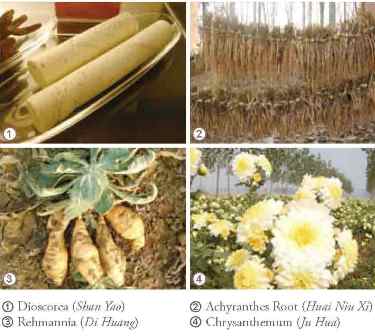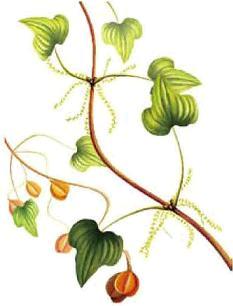Inspection of the Four Major Herbs of China’s Huai Region
Inspection of the Four Major Herbs of China’s
Huai Region
by Dr. Wu-chang Chuang
Deputy Director of Brion Research Institute of Taiwan
The Four Major Herbs of the Huai Region
Dioscorea (Shan Yao), Achyranthes Root (Huai Niu Xi), Rehmannia (Di Huang) and Chrysanthemum (Ju Hua) are four important herbs used in Chinese medicine. Specimens grown in the area once known as Huai Qing Fu (near the city of Jiaozuo, in Henan province) are highly valued, and are referred to as the Four Major Huai Medicinals.
The natural friable, fertile, and well draining soil found in that area along with its plentiful sunshine, ample rainfall, and warm climate are conducive for the growth of roots and rhizomes such as Dioscorea (Shan Yao), Achyranthes Root (Huai Niu Xi) and Rehmannia (Di Huang). It is also well suited for the cultivation of Chrysanthemum (Ju Hua). The Divine Husbandman’s Materia Medica (Shen Nong Ben Cao Jing) describes Dioscorea (Shan Yao), Rehmannia (Di Huang), Achyranthes Root (Huai Niu Xi) and Chrysanthemum (Ju Hua) produced in the “Tan Huai” area as superior medicinals. Later generations of well-known physicians continued to explore the inherent qualities of the Four Major Huai Medicinals.

1. Dioscorea (Shan Yao)
The Pharmacopoeia of the People’ s Republic of China (PPRC) lists Dioscorea (Shan Yao) as the dried root of Dioscorea opposite Thunb. of the Dioscoreacea family. In the winter months, after the stalk and leaves of the plant have withered, the root is unearthed, cleaned and the rootlets and skin are removed. The root is then dried whole or cut into slices to dry. Often the thickest and straightest dried roots are selected. They are soaked in water until completely saturated then cut into standard sized pieces and pressed into a cylindrical shape, sundried and finally polished. These crafted specimens are called “Guan Shan Yao”.
The nature of Dioscorea (Shan Yao) is neutral and its flavor is sweet. It enters the Spleen, Lung and Kidney channels. It supplements the Spleen, nourishes the Stomach, engenders fluids, benefits the Lungs, supplements the Kidneys, and astringes essence. It primarily treat symptoms such as poor appetite and chronic diarrhea, caused by Spleen deficiency, dyspnea and coughing due to Lung deficiency, Kidney deficiency with spermatorrhea, leucorrhea, and frequent urination, as well as deficiency heat with wasting and thirsting disorder.
Dioscorea (Shan Yao) dry-fried in wheat bran is said to supplement the Spleen and fortify the Stomach, and is used for those with Spleen deficiency and poor appetite, chronic loose stools or diarrhea, and excessive vaginal discharge.

Dioscorea (Shan Yao)
”Huai Shan Yao” (Dioscorea, 懷山藥) is often mistakenly written as ”Huai Shan” (淮山). Dioscorea (Shan Yao) produced around Jiaozuo city is considered to be the gold standard for quality. Roots grown in the area are long, slender and extremely straight, their skin is an earthy brown with dull purple-red spots, and fine rootlets densely cover its surface. The roots were thought to resemble an iron rod and hence earned the moniker “Tie Gun Shan Yao” (Iron Rod Shan Yao). The roots are very dense and don’t fall apart when cooked for a long time. They are also very flavorful, slightly sweet, and have a particularly wonderful texture when eaten. Dioscorea (Shan Yao) from Jiaozuo is used as both a food and medicinal.
Dioscorea (Shan Yao) from other regions have a different shape than that from Jiaozuo. Such as the Dioscorea (Shan Yao) from Hebei, which is shorter, plumper, and lacks a uniform thickness from middle to end. Because Dioscorea (Shan Yao) contains up to 85% water, traditional processing methods include fumigating with sulfur dioxide and pressing into a cylindrical shape in order to facilitate drying. Most of the Dioscorea (Shan Yao) roots sold in markets are white slices with a dense texture. It wasn’t until the 2005 edition of the PPRC that the phrase “fumigate with sulfur dioxide” was removed. Current processing methods emphasize hygiene and safety. After peeling the roots by hand, a machine is used to cut the root into slices, followed by treatment with hot air to dry the product. The result is that the processed product has a slight pinkish coloration and is less dense, somewhat like a potato chip. Using the new method eliminates the sulfur dioxide thus making the final product safer, as well as giving it a better texture.
Join our member to get full-text article! Join Free!
【Achyranthes Root (Huai Niu Xi)】for members only
【Rehmannia (Di Huang)】for members only
【Chrysanthemum (Ju Hua)】for members only